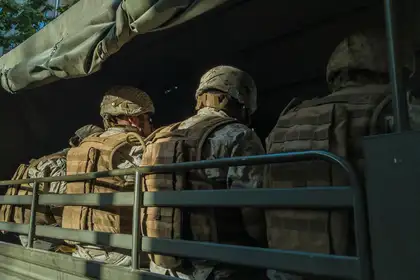
Recently, the New Zealand Defence Force (NZDF) received media attention regarding potential involvement in the three-way strategic defence alliance between Australia, the United Kingdom and the United States, (AUKUS), the additional investment required for the decaying Defence Estate, and the announcement New Zealand would supply six military personnel to the United States campaign against the Houthi militia attacking shipping in the Red Sea. These conversations are set in relation to a discussion about a disrupted international environment, the return of war in Ukraine and Gaza and great power competition where Russia, China and Iran are portrayed as posing military threats to NATO (North Atlantic Treaty Organisation) and the West. This week, we have had senior military leaders from Sweden (which is introducing conscription), United Kingdom and NATO arguing that the West must now prepare for war with Russia.
In the early 1990s, then British Prime Minister Margaret Thatcher and United States President George H. W. Bush argued that with the end of the Cold War, a peace dividend had emerged. This neoliberal notion being that as Western nations reduced military spending, the saved funds could be invested into economic growth and lower taxation. While support for this theory is mixed, it is evident most Western nations, including New Zealand, have appeared to spend less gross domestic product (GDP) on their militaries as they no longer needed to prepare for conventional warfare. Consequently, this decrease in spending has materialised as less focus on maritime and air defence and instead a focus on small scale conflicts, anti-submarine defence and nuclear deterrence.
Certainly in New Zealand, since the withdrawal from ANZUS, there have been debates about the role and function of the NZDF, how best it should be equipped and a decision to remove the air combat arm.
In the 1990s, the NZDF participated in United Nations deployments, while the 2000s saw Western coalition deployments to Afghanistan and Iraq as well as various continuing peacekeeping roles. Across this time, investment into the NZDF has been mixed and focused on maintaining existing capability.
Presently, the NZDF is in the process of replacing its C-130H (NZ) Hercules aircraft and maritime surveillance aircraft. But significant questions remain about the future costs of replacing the aging ANZAC frigates and the 737s, both of which have recently had high profile mechanical breakdowns. Retention rates and pay equity issues have seen significant attrition problems affecting the New Zealand military. Chief of Defence Force Air Marshal Kevin Short has recently highlighted the challenges faced by the NZDF in providing effective deployments, particularly in relation to the Cyclone Gabrielle response, noting that resolving these challenges might take up to 10 years. Consequently, the NZDF’s ability for concurrency (responding to more than one deployment simultaneously) is severely stretched.
The benefits of the peace dividend have resulted in a defence force requiring substantial investment to maintain current capability, let alone to evolve to combat the new forms of conventional, drone and cyberwarfare that are emerging in Ukraine and Gaza.
Conventional warfare components, such as future conflict-focused naval frigates, artillery and unmanned platforms (if deemed necessary) will incur additional significant cost. The takeaway here is that a modern military is expensive and requires significant investment.

Associate Professor William Hoverd is the Director of the Massey University Centre for Defence and Security Studies.
For many, the Cold War peace dividend is ending. In the face of Russian aggression, NATO nations are rearming. The China-United States tension has seen an escalation in military spending for both parties. China’s Navy is the largest in the world, comprising around 370 hulls, and the Pentagon estimates this number to grow to approximately 435 by 2030. Closer to home, Australia has recently joined the AUKUS partnership. This arrangement sees the sharing of nuclear propulsion technology between all three partners, enabling Australia to prolong the life of its current Collins-class submarine fleet supplemented by three Virginia-class submarines purchased from the United States. Additionally, Australia has committed to purchasing five AUKUS-class submarines by 2030. This move positions Australia, New Zealand’s sole military ally, as the seventh nation in the world to possess nuclear-powered submarines.
What will this mean for our nuclear free policy?
In 2023, both former Minister of Defence Andrew Little and Prime Minister Christopher Luxon expressed interest in exploring Pillar Two membership within AUKUS. However, Defence Minister Judith Collins recently noted that AUKUS membership remains a topic for future discussions. What exactly Pillar Two membership means is still unclear, but it seems to involve exclusive access to technology available only to the AUKUS partners. Opting to join AUKUS would certainly require additional investment and bring New Zealand further into the geopolitical rivalry that it entails. Importantly, here we see that decisions about NZDF capability are decisions about New Zealand’s geopolitical positioning.
With the peace dividend seemingly coming to an end, there seem to be three options for the NZDF and New Zealand.
1) We bravely decide to opt out of military spending or limit it. Professor Richard Jackson of the University of Otago has recently written a book which explores this alternative in detail.
2) We opt into AUKUS and the Western coalition, acknowledging the associated costs and potential conflicts. This would mean increasing the GDP spend on the NZDF. If you agree with the peace dividend, this security arrangement comes at the expense of social spending, economic growth and emerging expenditure areas. In Europe, this comes with discussions around civilian militaries and conscription.
3) What is more likely is that we maintain a middle ground by participating in the Western alliance on a more contingent basis. For example, we see a focus on Ukraine and the Red Sea rather than explicitly Gaza and China. Importantly, continuing this approach will still require additional investment considering the waning of NZDF architecture. This includes necessitates like frigate and 737 replacements, alongside investments in cyber and drone deterrence.
2024 looms as a pivotal year for seeing how the current coalition Government articulates and addresses Defence funding while defining New Zealand’s role in global politics. Certainly, first Minister Little and now Minister Collins represent a government shift by appointing a highly senior and capable Minister of Defence. We should take notice of that strategic deployment of political resource and watch Minister Collins’ statements closely.
Associate Professor William Hoverd is the Director of the Massey University Centre for Defence and Security Studies. He has recently published a book entitled State of Threat: The Challenges to New Zealand’s National Security.